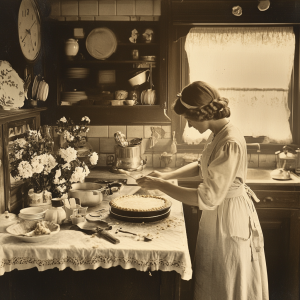
Grandma makes her famous pie
The Great Depression Diet: What Grandma Ate That Kept Her Alive and Sassy
(A throwback to resilience cooking—lard, vinegar pie, and how to make do without Instacart)
Before there was keto, paleo, or that juice cleanse that turned your insides into a Slip ‘N Slide, there was Grandma’s Depression-Era Diet—the original “eat to live” plan that came with a side of sass, survival, and Spam. No delivery apps, no 47-step smoothie bowls, and definitely no kale chips air-fried in unicorn tears. Just real food, real grit, and enough lard to make cardiologists twitch in their sleep.
Let’s rewind to the 1930s—a time when folks were broke, tired, and wondering who stole their financial security (spoiler: it wasn’t aliens, it was the economy). In those days, Instacart was called “your feet,” and dinner planning involved staring at a sack of flour and muttering, “Okay, now what?”
But somehow, Grandma made it work. She not only fed a family of nine with half a head of cabbage and a miracle, she also managed to stay sassier than a porcupine in a balloon shop. So what did she eat that kept her going? Let’s dig into the Depression Diet—hold the depression.
Lard: The Original Superfood (According to People Who Survived Real Stuff)
Forget avocado oil. In Grandma’s kitchen, lard was the duct tape of the pantry. Need to fry potatoes? Lard. Bake a pie? Lard. Shine your boots? Lard. Fight communism? Probably lard. It was cheap, shelf-stable, and tasted like comfort wrapped in bacon’s second cousin. And it didn’t come in a glass bottle with inspirational quotes either—it came in a tin that doubled as a drum for bored kids and an emergency lunch pail.
Now, before you clutch your organic coconut oil in horror, remember: lard kept families alive. It provided calories, flavor, and a certain outlaw charm. Bonus: it made biscuits flakier than your friend who always cancels plans but still wants to “catch up soon.”
Vinegar Pie: Dessert With an Attitude
No lemons? No problem. Grandma invented the vinegar pie—the “I Will Not Be Dessertless” manifesto baked into a crust. It had all the zing of lemon meringue but made from pantry staples and spite. Sugar, flour, vinegar, water, and whatever sass you had left—mix, bake, serve with pride. It was proof that resilience could be delicious, even if it made your eyebrows shoot up on the first bite.
Think of it as the sour patch kid of the pie world. First it stings, then it hugs you. You didn’t eat vinegar pie because you were fancy. You ate it because your mom gave you the look that said, “We will have pie, or so help me.”
(See recipe below)
Beans, Bread, and Bacon Grease
If you’ve ever had a cast iron skillet passed down like the family Bible, you know the holy trinity of survival food: beans, bread, and a spoonful of saved bacon grease. Beans were the protein, bread was the filler, and bacon grease was the fairy dust. It turned boring into bold and bland into “mmm, what is that?” (Answer: it’s flavor earned from yesterday’s breakfast.)
When meat was scarce, that grease got drizzled, fried, and sometimes whispered to in gratitude. People didn’t count macros—they counted blessings and biscuit crumbs.
Mock Everything: Because “Real” Was Expensive
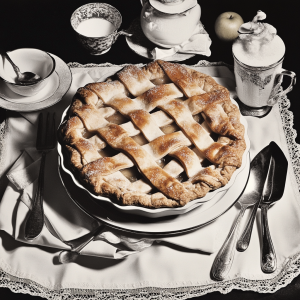
Mock apple pie
Mock apple pie made from crackers. Mock chicken legs made from rice and cereal. Mock coffee made from roasted chicory or desperation. The Great Depression menu was full of culinary cosplay—dishes pretending to be something fancier because dignity matters, even when your pantry looks like a sad magic trick.
Grandma wasn’t fooled. She knew those weren’t apples. But she’d smile, serve you a slice, and say, “Use your imagination, sugar. And chew slowly.”
The Fridge Was the Porch, and the Grocery Store Was the Garden
Refrigeration was for rich folks or people who weren’t currently heating the house with a trash fire. Leftovers went on the back porch in winter and grew penicillin in summer. Food preservation was a lifestyle: canning, root cellars, drying, pickling, and a healthy fear of spoilage.
And gardens? They weren’t “raised bed zen zones” with hashtags. They were war zones against rabbits, weather, and wilting. You grew what you could, you traded what you had, and you ate what survived. Even if it meant pickled beets showed up on the table one too many times and your cousin developed a twitch.
Now for the Real Stuff
Now, before you grab your apron and go full prairie-core, remember the deeper dish beneath the Depression Diet. It wasn’t about the food—it was about the mindset. Make do. Waste nothing. Feed people. Keep your humor. And when the pie is made of vinegar and your pantry looks like it lost a bet, you still set the table and eat with dignity.
This isn’t just a culinary history lesson. It’s a reminder that resilience can taste like day-old biscuits and still be sweet. That creativity comes from scarcity, and joy often follows a hard-won meal. Grandma didn’t need meal delivery or a Pinterest board—she had grit, a garden, and the ability to make soup from nearly nothing but hope and onions.
So the next time your grocery app glitches and you panic over being out of oat milk, just channel your inner Grandma. Fry something in lard. Bake something weird. Laugh at the chaos. And remember: survival doesn’t have to taste bland.
Sometimes, it tastes like vinegar pie—with a dollop of sass on top.
Grandma’s Vinegar Pie
(Also known as “Wait… What’s In This?” Pie)
Ingredients:
-
1 unbaked 9-inch pie crust (store-bought or homemade—no judgment from Grandma)
-
1 ½ cups water
-
1 cup granulated sugar
-
3 tablespoons all-purpose flour
-
2 tablespoons apple cider vinegar (white vinegar works in a pinch, but apple cider brings the sass)
-
2 tablespoons butter (lard works too—Grandma wouldn’t blink)
-
1 teaspoon vanilla extract
-
Pinch of salt
-
Optional: a dash of cinnamon or nutmeg if you’re feelin’ fancy
Instructions:
-
Preheat the oven to 400°F (205°C), or just “hot enough” if you’re going full vintage and baking by gut and guesswork.
-
In a saucepan over medium heat, combine water, sugar, and flour, whisking constantly. No lumps allowed—this is vinegar pie, not vinegar surprise.
-
Bring to a gentle simmer and cook until the mixture thickens a bit—about 5 minutes. If it coats the back of a spoon, you’re golden.
-
Remove from heat and stir in the vinegar, butter, vanilla, salt, and spices if using. Take a moment here to thank the pantry for not being empty.
-
Pour the mixture into the unbaked pie crust like you know what you’re doing. Smooth the top and whisper something encouraging. (“You’re weird, but you’ve got promise.”)
-
Bake for 25–30 minutes, or until the filling is set but still a little wiggly—like a good dance move or a toddler caught stealing cookies.
-
Cool completely before serving. Refrigerate if needed (or just stick it on the porch like Grandma did in 1932).
Serving suggestion:
Top with whipped cream, a scoop of vanilla ice cream, or just a wink and a tall glass of “We Made It Through Another Day.”
This pie is sweet, tangy, and unexpectedly delightful—kind of like Grandma after her third cup of percolator coffee.
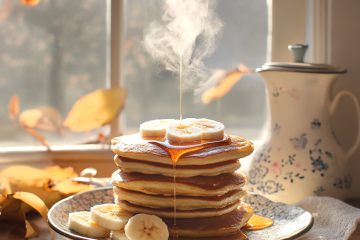
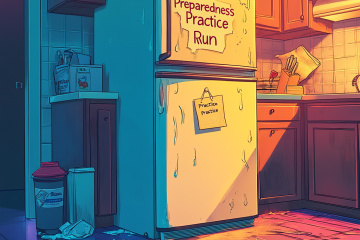
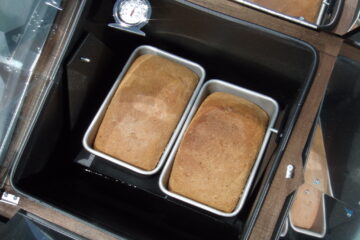
0 Comments